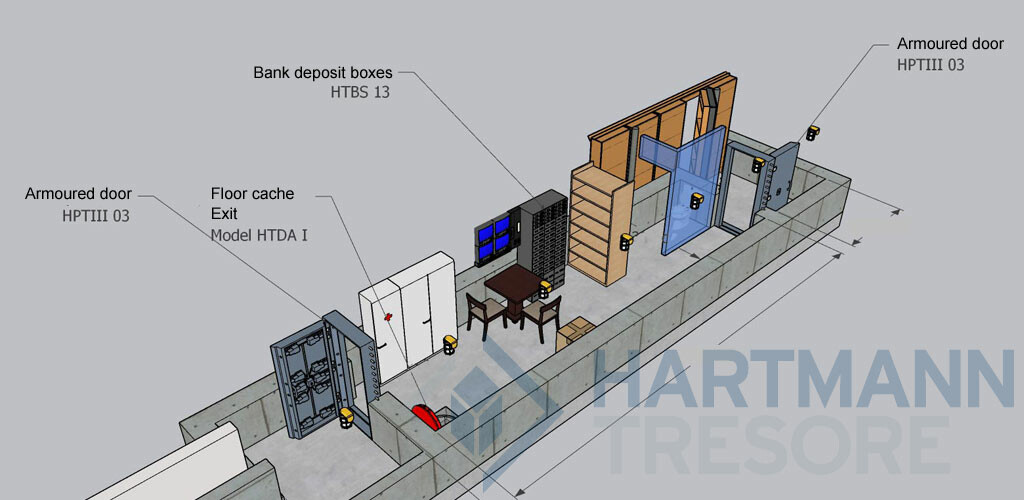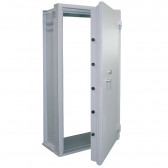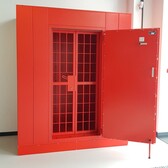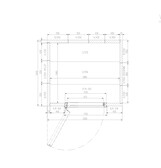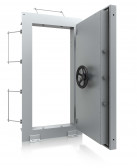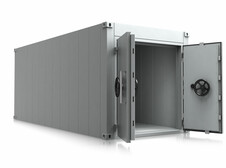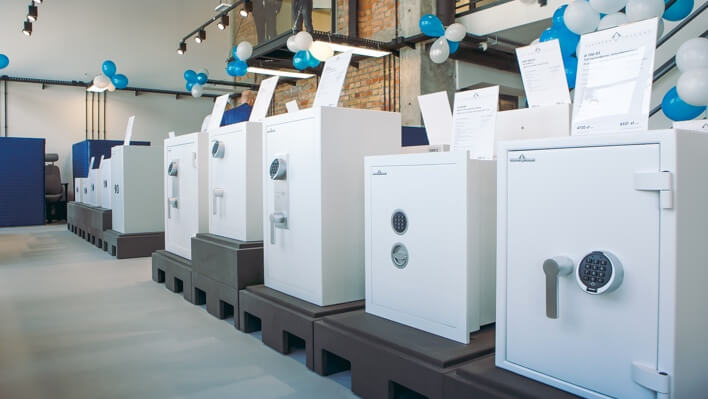Have you ever felt anxious when watching the news headlines? Geopolitical tensions, unpredictable weather phenomena, growing uncertainty about tomorrow... In times like these, it is natural to look for ways to protect what is most precious – your family, property, and above all, to seek a sense of safety – a secure refuge, shelter. Imagine a place that is your private fortress, a refuge isolated from external threats. A home shelter is not just a solid structure – it is a shelter that provides you and your loved ones with a sense of safety even in uncertain situations. A place where you and your family can feel safe, regardless of the circumstances. Sounds like a scene from a movie? Increasingly, it is becoming a real need and an investment in peace of mind.
Interest in home shelters, home bunkers and other protective solutions is growing rapidly in Poland. It is no longer just the domain of preppers or visionaries, but a conscious decision of many Britons – entrepreneurs, art collectors, families who care about the future. Just turn on any news channel to see that the threat is real. The war in Ukraine and rockets or drones falling on Polish territory or near our borders. War in the Middle East, which, although far away from us, has a vivid impact on our imagination. Internal threats such as mass immigration on the eastern border, rising crime, economic uncertainty and declining trust in state institutions.

As Hartmann Tresore Polska, experts in the field of security for over 150 years, we understand this need. We protect not only property, but also its owners. We specialise in top-class safes, armoured cabinets, cabinets for batteries or hazardous substances, as well as vaults and home shelters. At Hartmann Tresore, we know that true security is a system of interconnected vessels. That is why today we will take a closer look at the world of private home shelters – from definitions and available types to legal and financial aspects. We invite you to read on, as it may change your perception of security.
What exactly is a shelter? Understanding the definition to make a wise choice
Before we delve into technical and market details, it is essential to understand the basic terminology. Polish regulations, although evolving, distinguish between several key concepts:
- ● shelter: this is the most advanced form of protection. According to the definition, it is a protective structure with a closed and airtight design, equipped with specialised filter ventilation devices (often referred to as NBC systems – Nuclear, Biological, Chemical). A shelter is designed to provide protection against a wide range of threats, including shock waves, radiation and contamination, acting from all sides. Shelters are safe structures that effectively protect people and property in emergency situations. There are different classes of shelter resistance (e.g. P – basic, A – increased), which define the level of protection. The construction of shelters requires advanced earthworks and an individual approach to each project, taking technical aspects such as the thickness of walls and ceilings into account, as well as installations and ventilation, which are essential for the functionality of the shelter. The minimum ceiling thickness should be at least 40 cm to ensure adequate protection against shock waves and other hazards. The depth of the shelter's foundation is also important – the right depth affects the safety of the structure, but exposes it to groundwater and soil pressure. Shelters should be designed with maximum safety in mind.
- ● hideout: this is a non-airtight protective structure, equipped with simpler installations. It provides protection against specific impact factors (e.g. shrapnel, debris) coming from specific directions. Hideouts are also divided into resistance classes (I, II, III).
- ● home immediate hiding: this is a relatively new category, introduced in response to growing demand. It is defined as a free-standing protective structure with a non-airtight design and a usable area of up to 35 m². It is intended to protect the users of a residential building from the effects of military threats and extreme weather phenomena. Importantly, the construction of such a facility is subject to a simplified notification procedure.
- ● temporary refuge place: this category mainly refers to public facilities. These are existing buildings (e.g. basements, underground garages) adapted for the temporary shelter of people, but they are not specially designed or reinforced for protection. The government's "Shelters" app aims to inventory and share the locations of such places.
Understanding these differences is crucial. Home shelters are characterised by modern solutions that combine the highest safety standards with functionality. When deciding on a private solution, you need to know what level of protection you expect and what formalities you will be required to comply with. Remember that your safety is the most important thing here – you are not buying a ‘concrete box’, but investing in a solution to the problem of feeling unsafe.

What is a home shelter?
A home shelter is a structure designed to ensure protection of people and animals (possibly also of important equipment and assets, such as works of art) in various emergency situations, including natural disasters (catastrophes) and man-made disasters (armed conflicts), acts of terrorism, etc. The primary purpose of a home shelter is to provide a safe haven that will enable a family to survive in isolation from the outside world for a certain period of time. It is generally assumed that this can be from a few days to up to two weeks, depending on the type of threat and the equipment of the home shelter. Its size affects comfort, cost and the possibility of storing supplies.
A home shelter should be resistant to extreme weather conditions as well as the effects of warfare. Structural strength is one of the most important elements, which must be adapted to the specific needs and hazards that the shelter has to protect against. The shelter's structure should be resistant to high pressure caused by shock waves (armoured doors, including explosion-proof doors, depending on the threats). Resistance to shock waves concerns, among other things, the thickness of the walls and ceiling, as well as the reinforcement used in their fabrication, which must be designed to protect against a variety of events.
The design of a home shelter must be equipped with life support systems, primarily including air filtration. A modern filter ventilation system purifies the air of radioactive dust and other contaminants. If you cannot afford such solutions, simple gravity ventilation or a recuperation system with filters is the minimum requirement. In addition, the installations in the shelter should provide access to utilities and independent energy sources (e.g., solar panels connected to an energy storage facility). A water tank is also necessary in the shelter to ensure an adequate supply in emergency situations. A home shelter must contain food supplies with a long shelf life. Canned goods, military rations and freeze-dried food work best. Hygiene products, basic medicines and a first aid kit are also essential.
An underground home shelter should also be equipped with basic furniture, including beds, a table, chairs, as well as a toilet and a battery-powered radio. It is also worth remembering that a home shelter should be designed with maximum safety in mind, which is why it should be equipped with an alternative evacuation system that is independent of the entrance one.
Watch the construction of a home shelter.
Building a home shelter may seem like a big challenge, but as we have shown in our video, it is relatively simple. Hartmann Tresore Polska provides reinforcement materials, armoured doors, a locking system, gravity ventilation, a concrete recipe and a supervision inspector, and the whole project is carried out by the customer's construction company under our watchful eye. Hartmann Tresore Polska also builds modular home shelters in existing buildings. Locating these types of shelters underground increases their resistance to hazards. It is best if they are shelters that form an integral part of the building, located on the ground floor or in the basement. We advise against purchasing and installing underground metal, container or modular shelters. Some of them do not meet any standards, and some are old transformer stations adapted for use as shelters, which look beautiful in AI-generated graphics. In reality, these products only pretend to be home shelters and will not work in this role because their original purpose was different and their insulation from groundwater is only illusory. If you have any doubts, please contact us – our advisors are at your disposal.
Types of home shelters and bunkers available on the Polish market – a guide to the options
The market for private security solutions in Poland is growing rapidly, offering a wide range of options. The choice of the right type of security facility depends on needs and local conditions. When building home shelters, both technical and legal aspects must be taken into account.
Prefabricated shelters for general use are characterised by a simple and functional design, and their installation is quick, taking from one to several days. These shelters are delivered ready-made to the construction site. More secure but more expensive and difficult to construct are underground reinforced concrete shelters. There are many shelters of varying degrees of accessibility throughout the country. Here are the most popular types:
Underground shelters – the classic form of safety
This is often the first association with a bunker. Underground shelters, buried in the ground, are considered to offer the highest level of protection. The ground provides a natural barrier against many threats, and the solid construction (usually steel or reinforced concrete) ensures structural integrity. The depth of the excavation and foundation is crucial for the safety of the shelter, as it affects protection against groundwater and resistance to soil pressure.
Both ready-made, prefabricated underground shelters and modular structures are available on the market, which can speed up construction and potentially reduce costs. The building area of the shelter has a significant impact on the legal requirements for a notification or obtaining a building permit. A popular type of underground shelter is one built in basements or earth faults as an integral part of a building.
Depending on the terrain, these shelters are equipped with one or two independent entrances with armoured doors with handles that allow secure locking in a panic situation, and special hatches by which one can safely exit the home shelter and sometimes even the building in an emergency. One hatch is located in the home shelter and the other, usually concealed in an external wall or shed behind the house.
● advantages: highest level of protection, discretion.
● challenges: higher cost, complexity of construction, need for suitable ground conditions, in the long term, very serious problems with moisture and water seeping inside, requiring constant maintenance corrosion of steel elements, usually no emergency exit, problems with heating and thermal insulation of the hatch and water condensation in winter (not recommended except for the construction of a home shelter as a heated part of the building's basement).
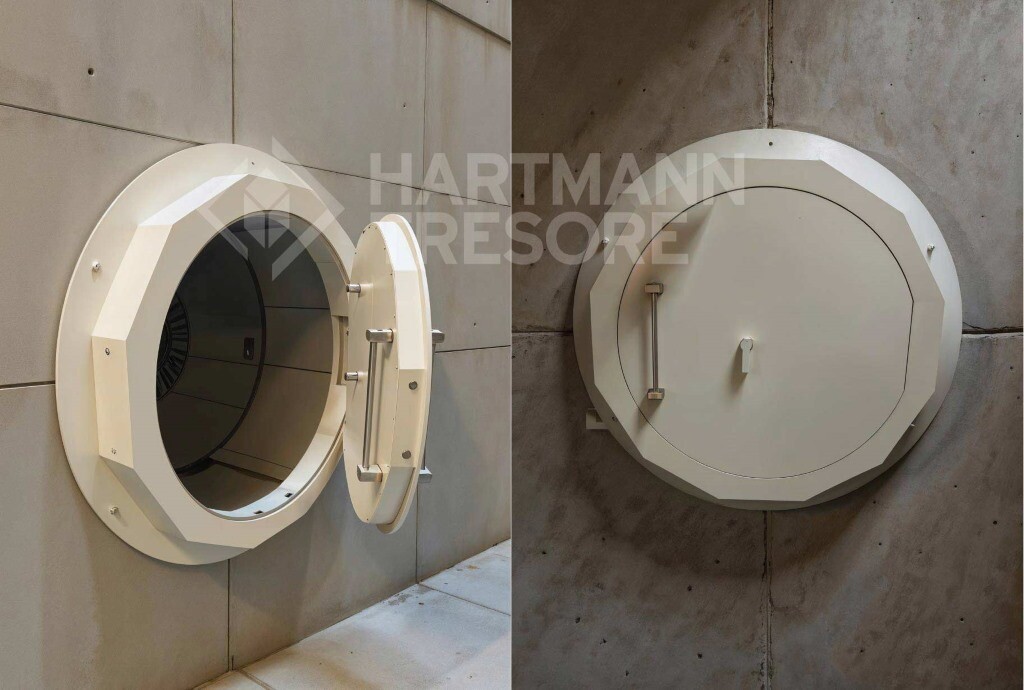
Above-ground shelters: When the ground is not an option
Sometimes geological, legal or logistical conditions make underground construction impossible. In such situations, above-ground shelters built on the surface may be the solution. Concrete and concrete-steel versions are available. Modular shelters are growing in popularity. Reinforced concrete modular structures stand out here, as they can be installed in virtually any location, although due to their weight and dimensions, the architectural conditions and statics of the building must be taken into account. Their installation can be easier and faster, and the level of protection (depending on the class and security measures used) is usually comparable to that offered by underground shelters.
See how a modular shelter was built in our showroom!
The construction of a concrete shelter with a larger area may require a building permit.
- ● advantages: can be built in difficult ground conditions, faster installation, greater durability, no problems with groundwater flooding, comparable durability to underground shelters, lower cost, can be integrated (fitted) into planned buildings, easier installation of an emergency exit from the shelter.
- ● challenges: less discretion.
Above-ground shelters can be designed in combination with above-ground terraces, which provide additional usable space and can help to conceal the shelter.
Basement conversion: A quick fix?
For many people, the most accessible option seems to be adapting an existing basement into a makeshift home shelter. This process usually involves reinforcing the walls and ceiling, sealing openings (doors, windows) and installing basic equipment such as a ventilation system. Converting a basement into a home shelter requires the installation of armoured doors equipped with a lock function from the inside without the possibility of closing them from the outside (if you are inside – a so-called panic handle).
● advantages: potentially the lowest initial cost, use of existing infrastructure, quick adaptation to the needs of a home shelter, quick availability and widespread use in the war in Ukraine demonstrate its usefulness.
● challenges: the level of protection is highly variable and depends on the scope of work (often far from shelter standards), difficulties in ensuring airtightness and adequate ventilation. The adaptation of a basement may also raise doubts as to whether it meets technical and legal requirements, so it is advisable to consult a specialist before starting work.
We recommend the article: Panic room in your home
Prefabricated shelters for general use: flexibility and speed
These are ready-made segments (modules) manufactured in a factory, transported to the site and assembled there (usually in existing rooms on the ground floor or in underground or multi-storey car parks). They offer considerable flexibility – they can be configured in terms of size and equipment to suit your budget and needs. Some companies even offer self-assembly kits, which reduce costs and ensure discretion, but most often provide illusory protection. Prefabricated shelters also offer the option of installing water and sewage tanks, which increases their functionality. Various standards are available – from economical to luxurious, fully autonomous bunkers. It is also possible to have a low-cost home shelter that meets basic safety requirements.
● advantages: faster installation than traditional construction, scalability, low price, lightweight construction (DIY).
● challenges: limitations in customisation compared to building from scratch, technical limitations at the installation site. Protection is usually illusory.
Portable shelters: safety wherever you are?
Although less common and less frequently discussed in the context of typical home shelters, there are also portable solutions. These are usually reinforced containers or special vehicles that can be moved. These facilities serve rather specific purposes, e.g. as temporary command centres, field laboratories or medical points in crisis areas. Portable shelters are used by the military and emergency services to protect personnel and equipment in areas of military operations. They usually require additional camouflage to make it difficult for the enemy to detect the mobile shelter. For individual users, their practicality as a permanent shelter is limited, but they can be part of a broader security strategy for companies operating in the field or individuals in need of temporary, reinforced space. Mobile shelters can also be equipped with emergency power systems that can be connected to the power grid, increasing their functionality in emergency situations.
● advantages: mobility, possibility of quick deployment in various locations.
● challenges: limited space and level of protection compared to permanent shelters, high cost of specialised solutions.
Legal aspects of building a shelter in Poland – what do you need to know?
For years, the construction of a private shelter in Poland was associated with legal uncertainty. There were no dedicated regulations, and investors often had to report such facilities as ‘dugouts’ or ‘wine cellars’, going through the standard procedure of obtaining a building permit. However, the situation is changing dynamically:
- ● Simplification for small shelters: the most important change is the amendment to the Building Law, which allows for the construction of temporary home shelters with an area of up to 35 m² on the basis of a notification, without the need to obtain a building permit. The exemption from the obligation to obtain a building permit applies to structures of a certain size, which significantly simplifies the construction process.
- ● Larger shelters: the construction of larger, more complex shelters (especially airtight ones that meet the definition of a ‘shelter’) will probably still require going through the standard procedure for obtaining a building permit in accordance with general regulations. The construction of larger shelters still requires a building permit.
- ● New regulations on the way: work is underway on a comprehensive law on civil protection and civil defence and the so-called ‘shelter law’. The Ministry of Development is involved in the preparation of these regulations. They aim to systematically regulate the issue of protective structures, including the potential introduction of an obligation to create shelters in new multi-family or public buildings. The draft amendment to the building law is intended to simplify the process of constructing shelters by eliminating the need to obtain a building permit for structures with an area of up to 35 m². Although the details regarding private shelters may still be crystallising, the direction of the changes indicates the growing importance attached to this issue by the state. These modifications are part of the government's programme objectives regarding citizen safety.
- ● Technical standards: there is currently a lack of uniform, official technical standards for private home shelters. Investors and companies often rely on standards for public buildings or foreign standards. The development of new technologies in shelter construction is supported by changes in building law. Discussions on the need to introduce such standards are ongoing. Details of the new regulations can be followed in the government's legislative agenda.
Recommendation: Always consult an architect or building law specialist before starting an investment to ensure that you are aware of the procedures applicable to your specific project. Refer to the authority of experts – remember that this is an investment for years to come. At Hartmann Tresore Polska, we have experience gained from the construction of military shelters, which we can use to build home shelters. Are you planning to build a house or company headquarters? Would you like to have a safe place to store your valuables on your property?
Key elements of shelter equipment – what will ensure survival and comfort?
A shelter is not just walls. In order for it to fulfil its function, it must be properly equipped. The list can be long and depends on the expected length of stay and the level of threat, but certain items are essential:
– life support system: proper shelter equipment is essential for its functionality and safety;
– ventilation/air filtration: an absolute must. Hermetic shelters require a filter ventilation system (NBC) to purify the air of dust, chemical and biological contaminants, and radioactive substances. Non-hermetic shelters require at least efficient gravity or mechanical ventilation;
– emergency power supply: an independent power source (generator, solar panels with energy storage) to maintain ventilation, lighting and communication;
– water and food supplies: an adequate amount of drinking water (at least several litres per person per day) and long-term food supplies;
– sanitary conditions: toilet (chemical, composting or connected to the system), personal hygiene products;
– first aid and medicines: well-stocked first aid kit, supply of essential medicines;
– communication: battery/crank-powered radio, charged power bank, possibly a satellite phone;
– emergency lighting: torches, battery-powered/crank lamps, candles (use with caution!);
– tools: basic tool kit, shovel, fire extinguisher;
– mental comfort: books, games, materials for children – items to help you survive isolation.
Practical advice: Create a checklist of equipment and regularly check the expiry dates of your supplies. Remember that social proof works – learn from experienced preppers and use proven solutions.
Checklist – shelter essentials
Remember that this list is only a starting point. In practice, adapt it to the number of people who will be using the shelter, the expected length of stay, the specifics of the shelter (airtight/non-airtight) and individual needs (e.g. medicines, baby needs).
I. Water:
– bottled water: at least 3-4 litres per person per day (for drinking, cooking, hygiene). A supply for at least 7-14 days, preferably longer;
– water containers: additional, clean containers for storing water;
– water filtration/purification system: water filters (e.g. gravity, pump), water treatment tablets, possibility of boiling water.
II. Food:
– long-term food: canned food (meat, fish, vegetables, fruit), freeze-dried food, rusks, energy bars, rice, pasta, groats, dried fruit, nuts, honey, sugar, salt. A supply for at least 7-14 days, preferably longer;
– food that does not require cooking: ready-to-eat meals (MREs), bars, ready-to-eat canned food, food with a long shelf life;
– essential utensils: can opener (manual!), dishes (plates, cups, cutlery – preferably metal or durable), pot/mess-tin (if possible);
– method of preparing meals: solid fuel/gas camping stove (with a supply of fuel/cartridges – use VERY carefully in enclosed spaces, ensuring ventilation!), chemical heaters.
III. Energy and lighting:
– emergency lighting: torches (preferably LED, hand-crank/dynamo and battery-powered), camping lamps, headlamps;
– spare batteries: various types, compatible with your devices;
– candles and matches/lighter: use with extreme caution due to the risk of fire and oxygen consumption;
– power banks: charged, preferably with a large capacity, possibly solar-powered;
– power source (if applicable): power generator (with fuel supply and exhaust system to the outside!), solar panels with converter and battery.
IV. Health and hygiene:
– first aid kit: fully equipped (dressings, disinfectants, painkillers, antipyretics, stomach medication, antiallergic medication, scissors, tweezers, thermometer, disposable gloves, FFP2/FFP3 protective masks);
– prescription medicines: individual supply of medicines taken on a regular basis (for at least 2 weeks, if possible);
– personal hygiene products: soap (preferably antibacterial), wet wipes, dry shampoo, toothpaste and toothbrushes, toilet paper, sanitary towels/tampons;
– disinfectants: hand sanitiser, surface disinfectant;
– bin bags: strong, various sizes;
– emergency toilet: bucket with toilet seat, chemical/portable toilet, supply of chemicals, cat litter (absorbs moisture and odours).
V. Communication and information:
– battery-powered/crank radio: for receiving local and national broadcasts;
– charged mobile phone (remember that the network may not be working);
– whistle: for signalling;
– important telephone numbers and addresses: written down on paper;
– local maps: paper maps of the area, evacuation plans.
VI. Tools and equipment:
– multitool or multifunctional pocket knife;
– fixed blade knife;
– adhesive tape (strong, duct tape type);
– rope or string;
– crowbar or small axe;
– shovel/entrenching tool;
– fire extinguisher: in working order, of the appropriate type;
– wrenches: basic set of flat and adjustable wrenches;
– plastic bags/tarpaulins.
VII. Comfort and clothing:
– warm clothing: several layers, thermal underwear, cap, gloves;
– underwear and socks;
– comfortable, sturdy shoes;
– sleeping bags and/or thermal blankets (NRC foil);
– sleeping mats or inflatable mattresses.
– books, board games, cards: something to pass the time, especially for children;
VIII. Documents and money:
– copies of important documents: identity cards, passports, birth/marriage certificates, insurance policies, title deeds, medical records. Stored in a waterproof container;
– cash: in various denominations (electronic payment systems may not work);
– USB stick with digital copies of documents and important files.
IX. Special needs:
– baby items: nappies, wipes, formula milk, baby food;
– pet food and water: if you plan to take them with you;
– glasses/contact lenses: spare pair;
– hearing aid: spare batteries.
Regular checks:
● Check expiry dates: food, water, medicines, batteries (every 6-12 months).
● Rotate your supplies: use older products and replace them with new ones.
● Check the condition of your equipment: torches, radio, tools, fire extinguisher.
● Update your documents and needs: medicines, children's clothing sizes, etc. change.
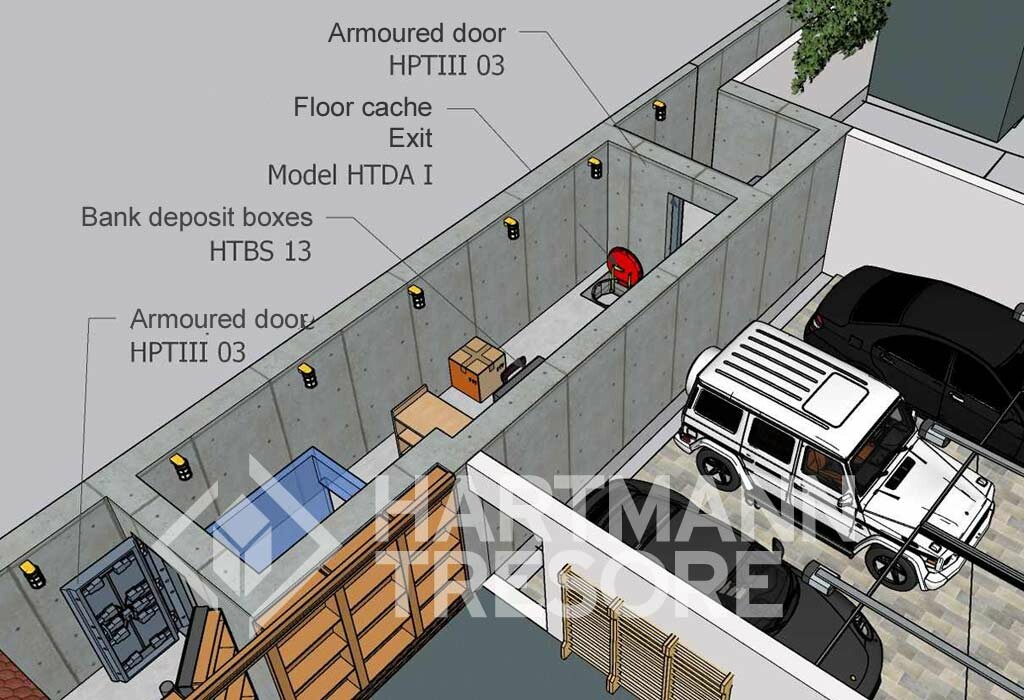
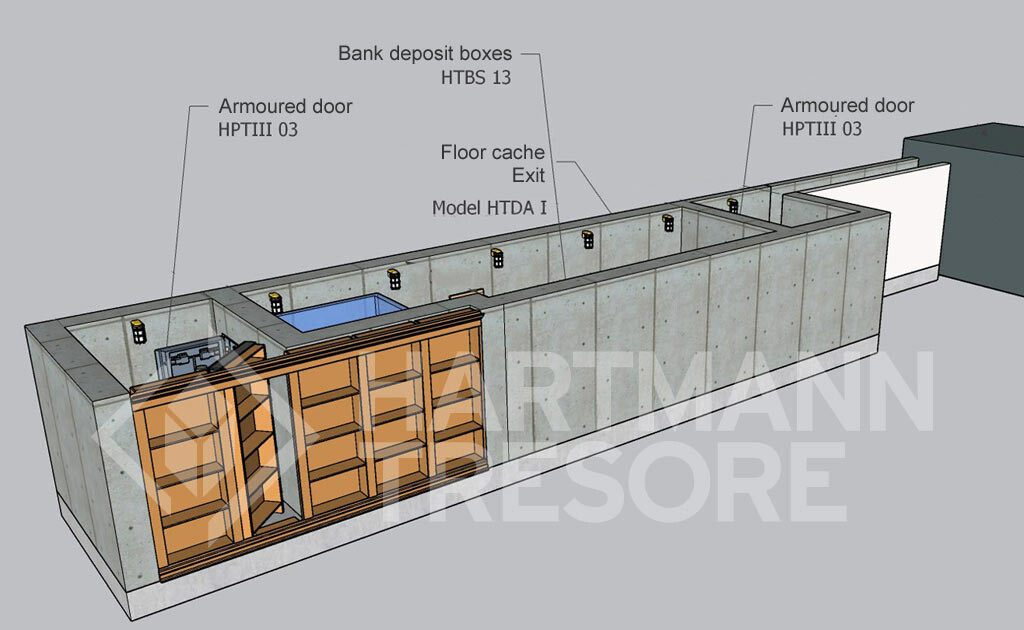
How much does peace of mind cost? The financial realities of investing in a shelter
One of the most frequently asked questions is: how much does it cost to build a shelter? The answer is: it depends. The prices of home shelters in Poland vary greatly – they range from several tens of thousands of zlotys for basic temporary shelters or basement conversions to several hundred thousand zlotys, or even several hundred thousand euros for advanced, fully equipped underground bunkers.
Factors affecting the cost:
● type and size of the shelter: underground shelters are usually much more expensive than above-ground ones, and a larger area means higher costs;
● materials: the quality and type of concrete, steel and sealing systems used;
● level of equipment: the cost of an NBC filter ventilation system, generator and monitoring systems can be significant;
● ground conditions and complexity of installation: difficult access and the need for large-scale earthworks increase costs;
● custom design vs. ready-made solution: custom designs are usually more expensive than prefabricated modules.
It is also worth noting that some investments, such as home shelters, may be exempt from the requirement to obtain a building permit, as they are part of the catalogue of exempt investments.
Although cost is a significant barrier, it is worth looking at it as an investment in safety and peace of mind. It is a solution to the problem of uncertainty. Remember that there are more budget-friendly options, such as the aforementioned home emergency hideouts (especially if you do some of the work yourself) or basic modular shelters.
The rule of unavailability may work slightly differently here – it is not about a limited number of shelters, but about limited time to prepare. It is better to act in advance than to look for solutions at the last minute, when prices and waiting times can increase dramatically.
Why choose Hartmann Tresore? Guarantee of maximum security
You may be wondering why a company specialising in safes is writing about shelters. The answer is simple: true security is comprehensive. A shelter protects your life and health in extreme situations, but also your most valuable possessions – documents, cash, jewellery, art collections, gold and other precious metals, digital data.
Even if you have a shelter, you need reliable solutions to secure valuable items inside it or in your home or business on a daily basis. This is where the expertise of Hartmann Tresore Polska comes in. Our certified safes (from home safes to the highest resistance classes for banks), armoured cabinets for documents and weapons, panic rooms and modular vaults are solutions built on the same principles: the highest quality, uncompromising resistance and discretion.
Our experience in designing and installing advanced security systems allows us to understand the challenges of protection on many levels. We take a holistic approach to security – from burglary protection, fire resistance and preparation for alarm installation to readiness for the most difficult evacuation scenarios. The rule of authority is indisputable here – over 150 years of tradition and thousands of satisfied customers (from private individuals to the largest institutions in the security industry and the military) speak for themselves.
Investing in security is investing in the future
The world is becoming increasingly unpredictable. Interest in home shelters and bunkers is no longer a fad, but a rational response to real concerns. Whether you opt for an advanced underground shelter, a practical modular shelter or a simple home temporary hideout, the most important thing is to take the first step – a conscious decision to increase your security.
Remember that protection has many layers. A shelter protects your life, but Hartmann Tresore Polska will help you protect everything else that is valuable to you. Do not wait until it is too late. Think about your future and the safety of your loved ones today.
Would you like to learn more about comprehensive security solutions for your home, business or collection? Contact the experts at Hartmann Tresore Polska. We will help you choose the right safe or security cabinet, and even advise you on issues related to securing your property in the context of owning a shelter.
Call or write to us today! Give yourself the peace of mind you deserve.
FAQ (Frequently Asked Questions)
- 1. What is the difference between a shelter and a hideout?
A shelter is an airtight structure with filtered ventilation, offering a high level of protection against various threats. A hideout is not airtight, with simpler installations, protecting against specific factors.
- 2. Do you need a permit to build a shelter?
To build a ‘home emergency hideout’ up to 35 m², all you need is a notification. Building larger or more complex shelters usually requires a building permit. It is always a good idea to check the current regulations.
- 3. How much does it cost to build a home shelter?
The costs vary greatly – from tens of thousands of zlotys for simple shelters or adaptations to several hundred thousand zlotys (or more) for advanced bunkers. The price depends on the type, size, materials and equipment.
- 4. What are the basic types of home shelters?
The most popular are: underground shelters (highest protection), above-ground shelters, adaptations of existing basements and increasingly popular modular (prefabricated) shelters.
- 5. What is most important in equipping a shelter?
The key elements are: an air ventilation/filtration system (e.g. NBC), an independent power supply, water and food supplies, sanitary facilities, a first aid kit, emergency lighting and means of communication.
- 6. Is converting a basement into a shelter effective?
It can provide a basic level of protection, but its effectiveness depends on the scope of the work carried out (structural reinforcement, sealing, ventilation). It rarely meets the standards of a real shelter, but it is better than no protection at all.

